
Dzogchen, also known as atiyoga, is a tradition of teachings in Indo-Tibetan Buddhism and Bon aimed at discovering and continuing in the ultimate ground of existence. The goal of Dzogchen is knowledge of this basis, this knowledge is called rigpa. There are spiritual practices taught in various Dzogchen systems for awakening rigpa.

The Kagyu school, also transliterated as Kagyü, or Kagyud, which translates to "Oral Lineage" or "Whispered Transmission" school, is one of the main schools of Tibetan Buddhism. The Kagyu lineages trace themselves back to the 11th century Indian Mahasiddhas Naropa, Maitripa and the yogini Niguma, via their student Marpa Lotsawa (1012–1097), who brought their teachings to Tibet. Marpa's student Milarepa was also an influential poet and teacher.

Mahāmudrā literally means "great seal" or "great imprint" and refers to the fact that "all phenomena inevitably are stamped by the fact of wisdom and emptiness inseparable". Mahāmudrā is a multivalent term of great importance in later Indian Buddhism and Tibetan Buddhism which "also occurs occasionally in Hindu and East Asian Buddhist esotericism."
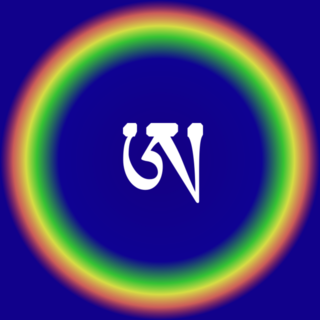
In Dzogchen, rigpa is knowledge of the ground. The opposite of rigpa is ma rigpa. A practitioner who has attained the state of rigpa and is able to rest there continuously is called a Rigdzin or Rigma, which may be used as a title either pre- or post-nominally.

Düsum Khyenpa was the 1st Gyalwa Karmapa, head of the Karma Kagyu school of Tibetan Buddhism.

Thrangu Rinpoche was born in Kham, Tibet. He was deemed to be a prominent tulku in the Kagyu school of Tibetan Buddhism, the ninth reincarnation in his particular line. His full name and title was the Very Venerable Ninth Khenchen Thrangu Tulku, Karma Lodrö Lungrik Maway Senge. The academic title Khenchen denotes great scholarly accomplishment, and the term Rinpoche is a Tibetan devotional title which may be accorded to respected teachers and exemplars.

The Shangpa Kagyu is known as the "secret lineage" of the Kagyu school of Vajrayana or Tibetan Buddhism and differs in origin from the better known Dagpo Kagyu schools. The Dagpo Kagyu are the lineage of Tilopa through his student Naropa, often traced through Naropa's famous student Marpa Lotsawa and thus called "Marpa Kagyu", while the Shangpa lineage descends from Tilopa's student Niguma, who was Naropa's sister, as well as from the teachings of Sukhasiddhi. Its founder was Khyungpo Naljor, the student of both women, whose monastery in the Shang Valley gave its name to the tradition.
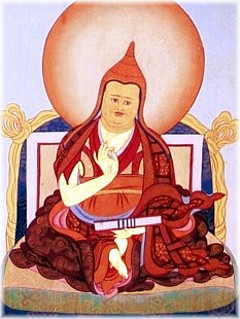
Jamgön Ju Mipham Gyatso, or Mipham Jamyang Namgyal Gyamtso (1846–1912) was a very influential philosopher and polymath of the Nyingma school of Tibetan Buddhism. He wrote over 32 volumes on topics such as painting, poetics, sculpture, alchemy, medicine, logic, philosophy and tantra. Mipham's works are still central to the scholastic curriculum in Nyingma monasteries today. Mipham is also considered one of the leading figures in the Rimé (non-sectarian) movement in Tibet.
In Tibetan Buddhism, Ngöndro refers to the preliminary, preparatory or foundational practices or disciplines common to all four schools of Tibetan Buddhism and also to Bon. They precede deity yoga.
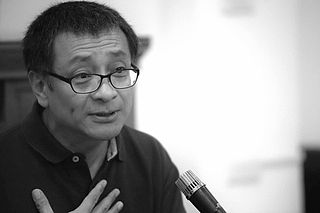
The 7th Dzogchen Ponlop is an abbot of Dzogchen Monastery, founder and spiritual director of Nalandabodhi, founder of Nītārtha Institute for Higher Buddhist Studies, a leading Tibetan Buddhist scholar, and a meditation master. He is one of the highest tülkus in the Nyingma lineage and an accomplished Karma Kagyu lineage holder.

Tulku Urgyen Rinpoche was a Buddhist master of the Kagyü and Nyingma lineages who lived at Nagi Gompa hermitage in Nepal. Urgyen Rinpoche was considered one of the greatest Dzogchen masters of his time.
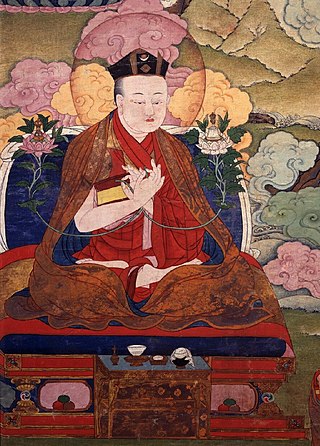
Rangjung Dorje (1284–1339) was the third Karmapa and an important figure in the history of Tibetan Buddhism, who helped to spread Buddha-nature teachings in Tibet.
Semde (Tibetan: སེམས་སྡེ, Wylie: sems sde; Sanskrit: cittavarga, "mind division", "mind class" or "mind series" is the name of one of three scriptural and lineage divisions within the Dzogchen tradition. The Nyingma school of Tibetan Buddhism traditionally classifies its Dzogchen teaching into three main divisions: Semde, Longdé and Menngagde.
Longdé is the name of one of three scriptural divisions within Dzogchen, which is itself the pinnacle of the ninefold division of practice according to the Nyingma school of Tibetan Buddhism.

The Trikāya doctrine is a fundamental doctrine within Mahayana and Vajrayana Buddhism that delineates the multidimensional nature of a Buddha's existence. This concept posits that a Buddha has three distinct bodies or aspects, each representing a different facet of enlightenment. The first body is the Dharmakaya, often referred to as the "Dharma body" or ultimate reality. This embodies the essence of enlightenment itself, encompassing concepts like emptiness, Buddha nature, and pure existence beyond material and spiritual forms.
In Vajrayāna Buddhism, esoteric transmission is the transmission of certain teachings directly from teacher to student during an empowerment (abhiṣeka) in a ritual space containing the mandala of the deity. Many techniques are also commonly said to be secret, but some Vajrayana teachers have responded that secrecy itself is not important and only a side-effect of the reality that the techniques have no validity outside the teacher-student lineage.
The Five Pure Lights is an essential teaching in the Dzogchen tradition of Bon and Tibetan Buddhism. For the deluded, matter seems to appear. This is due to non-recognition of the five lights. Matter includes the mahābhūta or classical elements, namely: space, air, water, fire, earth. Knowledge (rigpa) is the absence of delusion regarding the display of the five lights. This level of realization is called rainbow body.
The name Karma Chagme refers to a 17th-century Tibetan Buddhist (Vajrayāna) lama and to the tülku lineage which he initiated. Including the first, seven Karma Chagme tülkus have been recognized. The Neydo Kagyu sub-school of the Karma Kagyu was established by the first Karma Chagme, Rāga Asya.
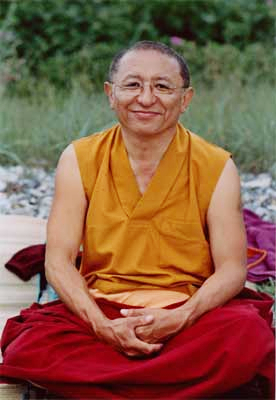
Chökyi Nyima Rinpoche is a Tibetan Buddhist teacher and meditation master. He is the abbot of Ka-Nying Shedrub Ling Monastery in Kathmandu, Nepal. He is the author of several books, founder of meditation centers around the world, and an international teacher.

The mind teachings of Tibet are a body of sacredly held instructions on the nature of mind and the practice of meditation on, or in accordance with, that nature. Although maintained and cultivated, to various degrees, within each of the major Tibetan Buddhist traditions, they are primarily associated with the mahamudra traditions of the Kagyu and the dzogchen traditions of the Nyingma.















